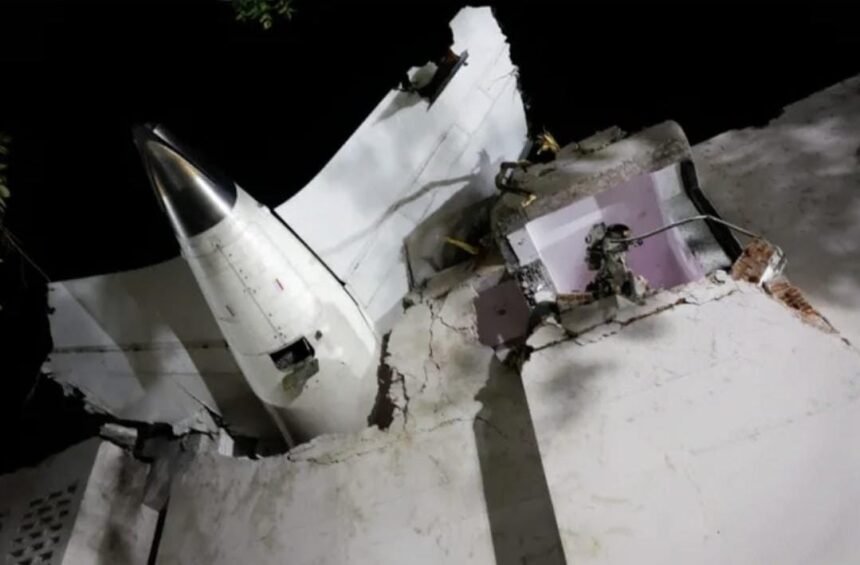On June 12, 2025, the Air India plane crash in Ahmedabad shook the world. The Boeing 787-8 Dreamliner, Air India plane crash Flight AI171, tragically crashed shortly after takeoff from Sardar Vallabhbhai Patel International Airport. The Air India plane crash has become one of the deadliest aviation disasters in recent history, claiming 241 lives and raising serious concerns about aviation safety. Among the 242 people on board, only one lone survivor managed to escape the wreckage, making the Air India plane crash a devastating event in air travel history.
Flight Details and Passengers on Board
The ill-fated flight AI171 was scheduled to depart from Ahmedabad at 1:39 PM local time and was on its way to London Gatwick Airport. Among the 242 people on board, there were 169 Indian nationals, 53 British citizens, seven Portuguese nationals and one Canadian. The passengers were mostly en route to various international destinations, including business travelers, tourists, and families.
Air India, the state-owned airline now under Tata Group’s ownership, confirmed the tragic accident hours after the plane lost contact with air traffic control. According to the airline’s statement, the flight was operating on a Boeing 787-8 Dreamliner, a modern, long-haul airliner that is part of a fleet known for its excellent safety record.
The Mayday Call and the Moment of Tragedy
At 1:39 PM, Flight AI171 took off from Ahmedabad’s Sardar Vallabhbhai Patel International Airport. Shortly after takeoff, the crew issued a Mayday call — a distress signal indicating a critical emergency. A Mayday call typically occurs when the crew faces a life-threatening situation, such as a technical failure or catastrophic system malfunction. The transmission was brief, and no further communication was received from the aircraft after the distress call.
Flight tracking data from Flightradar24 indicated that the aircraft’s last signal was detected mere seconds after it took off. Eyewitnesses reported that the plane appeared to struggle with gaining altitude before crashing into a residential area. The airplane was still in the vicinity of the airport, and the speed and altitude fluctuations suggested something had gone wrong soon after departure.
By 2:00 PM, the aircraft had lost significant altitude and plummeted to the ground in a fireball, with thick black smoke rising from the site. This marked the moment of tragedy, as the Boeing 787-8 Dreamliner crashed into a medical college hostel in Meghani Nagar, a residential area near the airport.
The Sole Survivor: Vishwashkumar Ramesh
Amid the horrific aftermath, there was one remarkable story of survival: Vishwashkumar Ramesh, a British national, was the only passenger to survive the crash.
Ramesh had been seated next to an emergency exit on the plane. After the plane crashed, he managed to unfasten his seatbelt and escape through the broken door of the aircraft, making his way to safety amidst the destruction. In his account to the media, he mentioned that he had no idea how he made it out alive. Upon regaining consciousness, he realized he had survived and was surrounded by bodies of his fellow passengers. He recalled that his brother, who was seated elsewhere on the aircraft, did not survive the crash.
Ramesh’s miraculous escape from a plane that had disintegrated in a matter of seconds was a stunning, albeit tragic, tale amidst the sorrow that enveloped the families of the other victims.
Victims on the Ground and the Impact on the Local Community
The plane crash not only caused the loss of 241 lives on board but also resulted in fatalities on the ground. Local reports indicate that at least eight people, including several students and faculty members, were killed when the aircraft struck the hostel. Among the victims were medical college students, as well as their relatives, who were staying in the building during the time of the crash.
Dr. Minakshi Parikh, the dean of BJ Medical College and Civil Hospital in Ahmedabad, confirmed the deaths of four of their students who were in the building when the plane collided. Additionally, four relatives of the medical college’s doctors also perished in the incident. Rescue teams arrived swiftly at the crash site, and emergency personnel began to assist survivors and extract bodies from the wreckage.
Emergency Response and Ongoing Investigation
In the aftermath of the crash, emergency services mobilized quickly, and efforts were made to contain the wreckage and rescue survivors from the site. Police, medical staff, and disaster management teams worked tirelessly to recover bodies and ensure that the area was safe.
The Aircraft Accident Investigation Bureau (AAIB) has taken charge of investigating the cause of the crash. The Indian government has also set up a high-level multidisciplinary committee to examine the causes behind this catastrophic event. The committee, led by the Union Home Secretary, will explore several aspects of the crash, including potential issues with the aircraft, operational procedures, and emergency response.
Aviation experts have raised questions about the aircraft’s flight path, particularly regarding the position of the landing gear, which was reportedly down during a phase of flight when it should have been up. This observation could help investigators understand the reasons behind the crash.
The committee will focus on reviewing existing safety protocols and standard operating procedures (SOPs) for managing such incidents. The investigation is expected to take several months, with a report due within three months. In addition, Air India has pledged to fully cooperate with the investigation and assist with the search for answers.
The Role of Boeing and Air India in the Investigation
The Boeing 787-8 Dreamliner, the aircraft involved in this crash, is known for its modern design and impressive safety record. Prior to this incident, it had never been involved in a fatal crash. The fact that this was the first recorded crash of a Boeing 787 has raised eyebrows, and experts are closely monitoring the investigation to uncover any potential flaws or issues with the aircraft.
Boeing’s CEO, Kelly Ortberg, expressed his condolences and confirmed that the company would support the investigation. Boeing representatives are already working alongside Indian authorities, and their technical expertise will be critical in understanding the technical factors that contributed to the crash. The company has also dispatched a team of experts to India to aid in the investigation.
Air India has assured the public that it is providing support to the families of the victims. The Tata Group, which now owns Air India, has announced compensation of ₹1 crore (approximately $120,000) to the families of those who perished in the crash. Additionally, Air India has set up dedicated hotlines to assist the victims’ families, providing information and support during this difficult time.
National and International Reactions to the Ahmedabad Plane Crash
The crash has reverberated across the world, with global leaders offering their condolences. Indian Prime Minister Narendra Modi expressed his deep sorrow over the tragedy, calling it “heartbreaking beyond words.” He also emphasized that the government would spare no effort to assist the affected families. Similarly, British Prime Minister Keir Starmer conveyed his shock and sympathy, as the crash involved many British citizens.
In a show of solidarity, U.S. aerospace companies have offered to collaborate with Indian authorities to determine the cause of the crash. The Federal Aviation Administration (FAA), along with GE Aerospace, has pledged to provide technical support in analyzing the aircraft’s flight data and cockpit recordings.
What Happened to the Aircraft?
Preliminary data from flight tracking websites such as Flightradar24 suggests that the aircraft’s last signal was sent just seconds after takeoff. The crash occurred rapidly and the aircraft’s descent appeared uncontrolled, leading to a ball of flames upon impact. Investigators are now focusing on whether mechanical failure, human error, or a combination of factors contributed to the disaster.
The Future of Air Safety: Lessons Learned
This disaster has raised several questions about aviation safety, especially concerning the Boeing 787-8 Dreamliner. Although the aircraft has a stellar safety record, the circumstances surrounding this crash will prompt a reevaluation of safety procedures for modern aircraft.
Furthermore, the role of emergency response teams, including both central and state authorities, will be under scrutiny. A thorough analysis of the rescue efforts and coordination will be conducted to identify areas for improvement.
Conclusion
The Air India AI171 crash is a sobering reminder of the fragility of life and the unpredictability of air travel. As investigators continue their work, the hope is that the lessons learned from this tragedy will lead to improved safety measures, better aircraft technology and more effective emergency protocols. For the families of the victims, the process of healing will be long and difficult but the support from the global community and ongoing investigations offer a glimmer of hope for answers.







